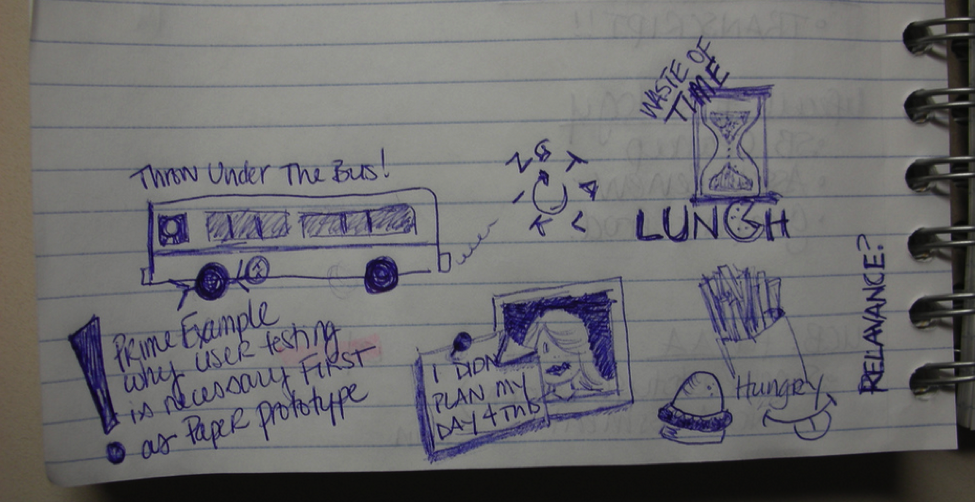

Have you ever left a meeting with more doodles than notes on your paper? Do you ever wish you could join your doodle stick-man on his adventures through the lines of your paper instead of staying in that meeting? That’s the unfortunate truth of many meetings I’ve attended.
It’s unfortunate because instead of being boring, meetings should be the most exciting part of the day. Meetings should be where decisions are made, where disagreements are aired, and where important problems are solved.
At Credera, our work can vary from ecommerce to business intelligence to change management, but regardless of the type of project, meetings are important and set the tone for the team as a whole. Teams vary, but meetings are universal. If you’re a part of a team effective meetings are an important part of your job.
This is part one of a four-part series where I’ll explore some ideas and practices that strive to scare that stick-man away from your meeting notes. As far as I know, there is no magic prescription for a perfect meeting, but I’ll cover some important reminders that can help in any type of meeting.
1. Don’t Skip the Agenda
I don’t think every meeting needs to be planned out to the minute with an accompanying slide deck—that’s overkill for most meetings. However, creating a basic agenda is critical. A good agenda forces you to consider the purpose or objective of the meeting. The act of creating an agenda gives you a chance to ensure you’ve got the correct audience and sufficient time planned.
Agendas don’t need to lay out a plan for world peace, so take five minutes before the next meeting you schedule to make sure you know the purpose of the meeting and the agenda, even if there’s only one topic to cover.
What if you didn’t call the meeting and there’s no agenda? Don’t let that stop you—put together some brief bullets for what you think the meeting should cover and ask the meeting organizer if your thoughts match the objective. Once you’re on the same page with the organizer, ask if an agenda can be sent to the attendees. It’s not about showing-up the organizer—just tell them you want to make sure you’re prepared appropriately. They might even thank you.
2. Don’t Be Afraid to Break the Agenda
Yes, I know. I just said that the agenda is critical, and it is. Typically, I try to stick to the agenda. Best laid plans are not always perfect though, so there will be times where you need to make the call to break the agenda.
I’m not suggesting this should be a frequent occurrence, but if you get into a topic and learn it needs to be explored, don’t stick to your agenda like a rule book. I’ve even scheduled a few meetings where I had to cancel the meeting a few minutes in because we were missing a critical person and unable to make a decision without them.
3. Start With the “Why”
If your schedule is anything like mine, you’re frequently asked to shift gears throughout the day. Our jobs are rarely focused on only one thing. This is a good thing because only having one task sounds a little boring to me. But the multi-tasking nature of the workday can introduce distractions to your meeting’s purpose. To make sure the meeting audience knows the purpose, take a minute or two at the beginning of each meeting to share the “why” of the meeting.
The “why” is more than the objective statement that may be at the top of a formal agenda. The “why” gives your meeting participants an understanding for the discussion. It’s more than just what you want to get out of the group—it’s also why the meeting should be important to the group.
For example, the “why” to discuss the plan for the next quarter should be more than an objective statement:
“I want to share my plans for the next quarter.”
The “why” should truly matter to each of the attendees:
“I want to share my plans for the next quarter because we’ve been burning the candle at both ends recently, and I think if we come together on this plan, we can we can cut back on the extra hours that the team has needed to work.”
Even a recurring status meeting can start with the “why.” I’m not talking about a long objective statement, but a quick reminder of why this meeting is important can take some of the drudgery out of a meeting.
4. Identify Next Steps
Have you ever left a meeting feeling bummed or even angry that you talked about a lot but you’re no closer to reaching a decision? One way to combat that end-of-meeting depression is to make sure to save a few minutes to lay out the next steps or “action items”.
Taking the time to identify next steps ensures that when a meeting didn’t fully meet its goals, the topic progresses forward—even if only in a small way—toward the ultimate objective.
Make sure someone writes down the next steps and sends them to the group after the meeting. Not all meetings need long formal meeting minutes, but most meetings need at least a brief summary of any decisions made and/or the next steps the team will take.
In the next meeting you organize, think about these tips and maybe you’ll be able to scare off the stick-men from your team’s notes. In part two, I’ll take a closer look at one of the most commonly hated meetings: the dreaded status meeting.
Contact Us
Let's talk!
We're ready to help turn your biggest challenges into your biggest advantages.
Searching for a new career?
View job openings